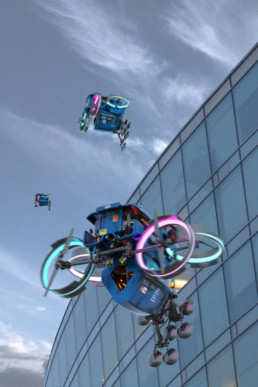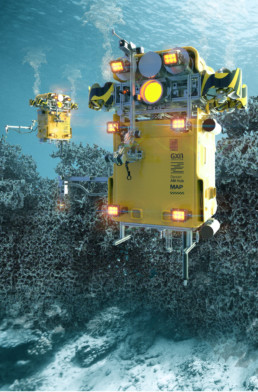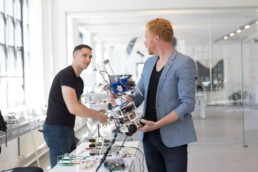Moonshots
Break the Grid
Af og til har man brug for en overflod af kreativitet og ambition til at skubbe til grænserne for, hvad 3D print kan præstere, nu og i fremtiden. Vi kalder disse projekter for Moonshots – netop fordi de skyder efter månen! Vi igangsætter og støtter Moonshots med udvalgte samarbejdspartnere.
Break the Grid opstod på baggrund af en undren og et ønske om, at lade 3D printere bevæge sig. De printere man kender i dag printer på et givent område (inden for en firkant). Ved at lade 3D printere bevæge sig, opstår der en verden af nye muligheder. Hvis vi lader 3D printeren dykke under vand vil den så kunne reparere skibe under vand, genopbygge koralrev eller sikre kyster, der er udsat for klimaforandringer? Hvis vi lader 3D printere flyve kan den så reparere tage uden, at vi skal sætte stillads op, eller tætne vinduer på skyskrabere? Og lader vi dem kravle eller gå, vil de så kunne hjælpe til på byggepladser? Spørgsmål der åbner for en verden af muligheder med 3D printere, der rummer potentialet til at bidrage til løsninger på nogle af de store samfundsudfordringer, vi står overfor grundet klimaforandringer.
Læs mere og lad dig inspirere af projektet:
Break the Grid full presentation
Press release
Buildings, infrastructure and cities across the globe are straining under the combined pressures of explosive population growth and a warming climate. A new research initiative, Break the Grid, explores how 3D printers can be made to move autonomously in order to meet these global challenges. Break the Grid is developed by GXN Innovation, the independent research company of renowned Danish architecture firm 3XN, in collaboration with The Danish AM Hub, Denmark’s platform for digital and additive manufacturing, and Copenhagen-based Map Architects. Through a series of mechanical and virtual hacks of existing 3D printers, the design partners envision faster, cheaper and more efficient methods of responding to urban, social and environmental change.
Break the Grid is part of the Danish AM Hub Moonshots initiative, which focuses on the power of design to create a better world. The project team identified three distinct scenarios for autonomous additive manufacturing, a crucial element of an imagined near future in which advances in robotics and machine learning have mobilized 3D printers to roam our natural and man-made environments, while solving pressing urban challenges. The team used existing printing and sensing technology to create mobile mechanical prototypes of 3D printers. Based on these prototypes, the team explored virtual hacks for mobile printing on land, under water, and in the air.
“Freeing 3D printers to meet these challenges could be a revolution in the making,” explained Kasper Jensen, Founder of GXN. “By enabling robots to crawl, swim, and fly, we can address pressing environmental threats around the world at lower cost and with greater efficiency.”
One global challenge that the proposal addresses is the current state of deterioration in our global infrastructure. Micro-cracks are a starting point for further damage to concrete infrastructure, as these cracks allow water and oxygen into the structure, leading to corrosion. The project team hypothesizes that 3D printers can be used to repair these micro-cracks using a porous filler mixed with the fungus Trichoderma Reesei, which promotes the formation of calcium carbonate. Autonomous hexapods, the proposal theorizes, would be able to wander the length of urban and remote concrete infrastructures, scanning for structural integrity and repairing the micro-cracks before they lead to greater damage.
A second global challenge addressed by the proposal is the increasingly damaging effect of climate change on coastal habitats. More than 10% of the world’s coastal populations live less than 10 meters above seal level, and are becoming more vulnerable to coastal storm surges and catastrophic tsunamis. Inspired by a specialized adhesive produced by oysters, researchers have developed synthetic glues with the same properties. GXN and its partners envision underwater 3D printing ROVs that would mix this glue with ocean floor sands, and create a wet-setting binder that would build artificial reef structures to protect the coasts and also provide vital habitats for marine life.
The third global challenge addressed is the significant heat and energy loss that results from aging high-rise buildings in major cities. Many existing facades require repair or better insulation to combat degradation and energy loss. Researchers are exploring how functionally graded materials could combine glass with high-performing polymers to provide new thermal insulation to old buildings. Break the Grid conceives of a drone-based printing system for identifying and filling thermal bridges in these older, high-rise buildings, allowing for efficient material-based solutions on a case by case basis, with lower investment requirements and minimal human interaction.
“Converging technologies are enabling new approaches to construction,” explained Mads Kjøller Damkjær, CEO of The Danish AM Hub Fund. “We hope to inspire the additive manufacturing industry to envision new possibilities, which will require combining design and technology to shift our values and our current ways of thinking.”
About Danish AM Hub
Danish AM Hub is a philanthropic foundation and Denmark’s new platform for additive manufacturing. The AM Hub seeks to bring together the Danish ecosystem to combine, change and advise on AM, with the aim of getting industry to see the multifaceted potential of the AM technology. Danish AM Hub is initiated by The Danish Industry Foundation.
AM Hub team – CEO: Mads Kjøller Damkjær; Project Manager: Lars Holmegaard; Communications: Vibeke Agerdal Kristiansen
About GXN Innovation
GXN innovation was established in 2007 as the independent research company of 3XN architects. GXN seeks to advance new approaches to environmentally beneficial design in all its diversity and across its material, technical and social dimensions. GXN combines behavior design, circular design and digital design to push the boundaries of architecture and enrich the lives of people and environments.
GXN team – Partner in charge: Kim Herforth Nielsen and Kasper Guldager Jensen; Project leader: Kåre Stokholm Poulsgaard; Specialist: Teodor Petrov
About MAP Architects
MAP Architects, based in Copenhagen, is active globally, engaged mostly with projects in challenging environments. The firm’s design work spans various scales and spheres of action, often challenging the status quo through inventiveness and a cross-disciplinary approach.
MAP Architects team – Founder: David A. Garcia






